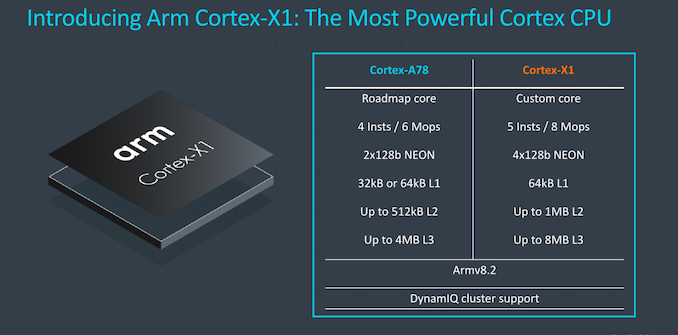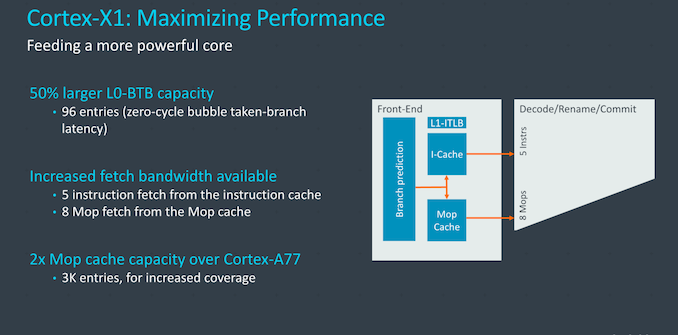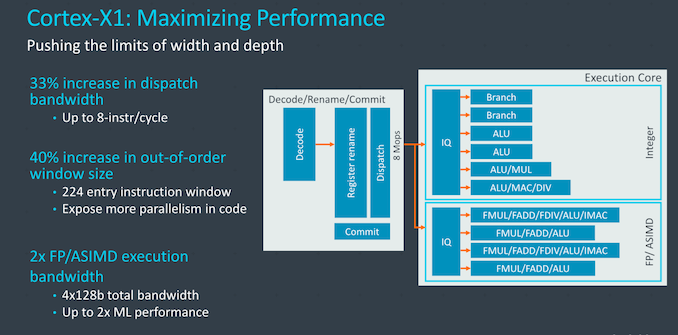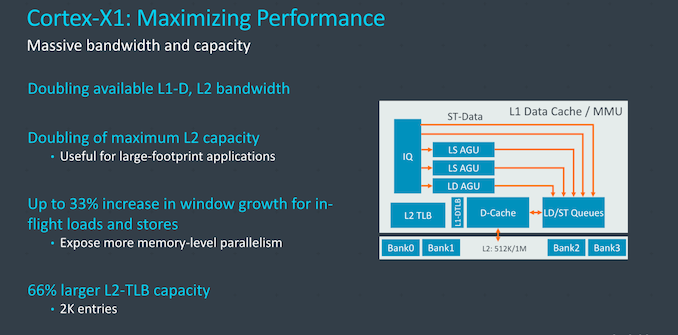Arm's New Cortex-A78 and Cortex-X1 Microarchitectures: An Efficiency and Performance Divergence
by Andrei Frumusanu on May 26, 2020 9:00 AM EST- Posted in
- SoCs
- CPUs
- Arm
- Smartphones
- Mobile
- GPUs
- Cortex
- Cortex A78
- Cortex X1
- Mali G78
The Cortex-X1 Micro-architecture: Bigger, Fatter, More Performance
While the Cortex-A78 seems relatively tame in its performance goals, today’s biggest announcement is the far more aggressive Cortex-X1. As already noted, Cortex-X1 is a significant departure from Arm's usual "balanced" design philosophy, with Arm designing a core that favors absolute performance, even if it comes at the cost of energy efficiency and space efficiency.
At a high level, the design could be summed up as being a ultra-charged A78 – maintaining the same functional principles, but increasing the structures of the core significantly in order to maximize performance.
Compared to an A78, it’s a wider core, going up from a 4- to a 5-wide decoder, increasing the renaming bandwidth to up to 8 Mops/cycle, and also vastly changing up some of the pipelines and caches, doubling up on the NEON unit, and double the L2 and L3 caches.
On the front-end (and valid the rest of the core as well), the Cortex-X1 adopts all the improvements that we’ve already covered on the Cortex-A78, including the new branch units. On top of the changes the A78 introduced, the X1 further grows some aspects of the blocks here. The L0 BTB has been upgraded from 64 entries on the Cortex-A77 and A78, to up to 96 entries on the X1, allowing for more zero latency taken branches. The branch target buffers are still of a two-tier hierarchy with the L0 and L2 BTBs, which Arm in previous disclosures referred to as the nanoBTB and mainBTB. The microBTB/L1 BTB was present in the A76 but had been subsequently discontinued.
The macro-op cache has been outright doubled from 1.5K entries to 3K entries, making this a big structure amongst the publicly disclosed microarchitectures out there, bigger than even Sunny Cove’s 2.25K entries, but shy of Zen2’s 4K entry structure - although we do have to make the disambiguation that Arm talks about macro-ops while Intel and AMD talk about micro-op caches.
The fetch bandwidth out of the L1I has been bumped up 25% from 4 to 5 instructions with a corresponding increase in the decoder bandwidth, and the fetch and rename bandwidth out of the Mop-cache has seen a 33% increase from 6 to 8 instructions per cycle. In effect, the core can act as a 8-wide machine as long as it’s hitting the Mop cache.
On the mid-core, Arm here again talks about increasing the dispatch bandwidth in terms of Mops or instructions per cycle, increasing it by 33% from 6 to 8 when comparing the X1 to the A78. In µops terms the core can handle up to 16 dispatches per cycle when cracking Mops fully into smaller µops, in that regard, representing a 60% increase compared to the 10µops/cycle the A77 was able to achieve.
The out-of-order window size has been increased from 160 to 224 entries, increasing the ability for the core to extract ILP. This had always been an aspect Arm had been hesitant to upgrade as they had mentioned that performance doesn’t scale nearly as linearly with the increased structure size, and it comes at a cost of power and area. The X1 here is able to make those compromises given that it doesn’t have to target an as wide range of vendor implementations.
On the execution side, we don’t see any changes on the part of the integer pipelines compared to the A78, however the floating point and NEON pipelines more significantly diverge from past microarchitectures, thanks to the doubling of the pipelines. Doubling here can actually be taken in the literal sense, as the two existing pipelines of the A77 and A78 are essentially copy-pasted again, and the two pairs of units are identical in their capabilities. That’s a quite huge improvement and increase in execution resources.
In effect, the Cortex-X1 is now a 4x128b SIMD machine, pretty much equal in vector execution width as some desktop cores such as Intel’s Sunny Cove or AMD’s Zen2. Though unlike those designs, Arm's current ISA doesn't allow for individual vectors to be larger than 128b, which is something to be addressed in a next generation core.
On the memory subsystem side, the Cortex-X1 also sees some significant changes – although the AGU setup is the same as that found on the Cortex-A78.
On the part of the L1D and L2 caches, Arm has created new designs that differ in their access bandwidth. The interfaces to the caches here aren’t wider, but rather what’s changed is the caches designs themselves, now implementing double the memory banks. What this solves is possible bank conflicts when doing multiple concurrent accesses to the caches, it’s something that we may have observed with odd “zig-zag” patterns in our memory tests of the Cortex-A76 cores a few years back, and still present in some variations of that µarch.
The L1I and L1D caches on the X1 are meant to be configured at 64KB. On the L2, because it’s a brand new design, Arm also took the opportunity to increase the maximum size of the cache which now doubles up to 1MB. Again, this actually isn’t the same 1MB L2 cache design that we first saw on the Neoverse-N1, but a new implementation. The access latency is 1 cycle better than the 11-cyle variant of the N1, achieving 10 cycles on the X1, regardless of the size of the cache.
The memory subsystem also increases the capability to support more loads and stores, increasing the window here by 33%, adding even more onto the MLP ability of the core. We have to note that this increase not merely refers to the store and load buffers but the whole system’s capabilities with tracking and servicing requests.
Finally, the L2 TLB has also seen a doubling in size compared to the A78 (66% increase vs A77) with 2K entries coverage, serving up to 8MB of memory at 4K pages, which makes for a good fit for the envisioned 8MB L3 cache for target X1 implementations.
The doubling of the L3 cache in the DSU doesn’t necessarily mean that it’s going to be a slower implementation, as the latency can be the same, but depending on partner implementations it can mean a few extra cycles of latency. Likely what this is referring to is likely the option for banking the L3 with separated power management. To date, I haven’t heard of any vendors using this feature of the DSU as most implementers such as Qualcomm have always had the 4MB L3 fully powered on all the time. It is possible that with a 8MB DSU that some vendors might look into power managing this better, for example it having being only partially powered on as long as only little cores are active.
Overall, what’s clear here about the Cortex-X1 microarchitecture is that it’s largely consisting of the same fundamental building blocks as that of the Cortex-A78, but only having bigger and more of the structures. It’s particularly with the front-end and the mid-core where the X1 really supersizes things compared to the A78, being a much wider microarchitecture at heart. The arguments about the low return on investment on some structures here just don’t apply on the X1, and Arm went for the biggest configurations that were feasible and reasonable, even if that grows the size of the core and increases power consumption.
I think the real only design constraints the company set themselves here is in terms of the frequency capabilities of the X1. It’s still a very short pipeline design with a 10-cycle branch mispredict penalty and a 13-stage deep frequency design, and this remains the same between the A78 and X1, with the latter’s bigger structures and wider design not handicapping the peak frequencies of the core.














192 Comments
View All Comments
Quantumz0d - Tuesday, May 26, 2020 - link
First things first, so what's the cost here of the new X1 vs the 78, we already have $1000 for the smartphone planned obsolescence and now this is next level uber crazy alien tech is going to make them go for obscene $2000 non user replaceable battery junk tech gadgets ?Going wider and 3GHz I don't know maybe maybenot, Zen doesn't clock higher because of it's wider arch from what I saw and the 7N limitations. Even Intel is going wider next, which is going to get hit in the pure clockspeed.
And next, this is hilarious - " they should outright panic at these figures if they actually materialize – and I do expect them to materialize"
Outright panic ? - Let's look at facts 95% Intel, 4.5% AMD from Q4 2019 - Server Marketshare & wonder where does ARM sit here to make both Intel and AMD "Panic".
ARM always about custom this custom that BS, Every single thing needs to be made custom for that crappy ARM part and the LGA socket system is not even a standard for these ARM Server CPUs and x86 is all about the Sockets and in the Consumer space mobile and DIY it doesn't exist, thanks to the Software which is a bigger driving force behind any product in this specturm, esp everyone knows Qualcomm's ever marketed (by Cloudflare) Centriq 2400 10nm Server CPU got deleted from it's existence and even stopped pursuing such goals, where they even put full Kryo SD820's full custom engineers on it and even the guy who was spearheading also moved on.
I will wait to see what's going to happen to the ever bashed x86 by the ARM superiority or the Apple A series Alien processors.
ah06 - Wednesday, May 27, 2020 - link
Those are the facts as of now yes. But the rest of the post sounds like someone about to get disrupted. The bulk of x86 vendor profits come from laptops, specifically general use thin, light and cheap laptops, those are about to be disrupted. Which is to say that in 5 years time, x86 on laptops will cease to exist in any meaningful way. Desktops/Enthusiast parts are not financially relevant to any of these companies.Drake H. - Wednesday, May 27, 2020 - link
Nah. The servers are the pot of gold, where profit margins are really high.You will soon see that ARM will have its small space, but it does not pose a danger to the duopolio x86, something very complex will be coming and everything is already sealed with patents.
Drake H. - Wednesday, May 27, 2020 - link
https://www.phoronix.com/scan.php?page=article&... Here's an example of how ARM outperforms x86. XDYojimbo - Tuesday, May 26, 2020 - link
Hera hated Hercules.vladx - Tuesday, May 26, 2020 - link
We need Zeus next.jaju123 - Tuesday, May 26, 2020 - link
Disappointed that there's no replacement for the ancient a55 yetKamen Rider Blade - Tuesday, May 26, 2020 - link
I concur, A55/A78 still on ARMv8.2-AARM is already on ARMv8.6-A
And there are already announced new CPU instructions coming down the pipe.
https://en.wikipedia.org/wiki/ARM_architecture#Fut...
In May 2019, ARM announced their upcoming Scalable Vector Extension 2 (SVE2) and Transactional Memory Extension (TME).
Raqia - Tuesday, May 26, 2020 - link
It's an interesting drop for this year's ARM tech day: I imagine A78 plans were nebulous when the A76 dropped, and they may have downscaled what is now called the A78 and upscaled what's now the X1. There will likely be a 9cx part for Windows on ARM that can leverage the higher end cores and larger caches very well, but really looking forward to Matterhorn and their new smaller core design which will be very impactful for mobile performance.StormyParis - Tuesday, May 26, 2020 - link
To me, these stories are always kind of exciting and kind of pointless. I'm no longer buying flagships, and even at the low/mid-range, it's been years since I've had, or have heard, a complaint about performance.The apps we use haven't changed in 5 years. Maybe some games, but VR never took off, and InstaGram/Twitter/Maps/FB... are the same. "As long as it has a Core A7x, it is Delightful." Hopefully the X program will help ARM get into consoles, laptops and desktop, and hopefully Android will start supporting that... even today, it's more of an Android problem than an ARM problem. Maybe Windows will fix what Google fumbled.